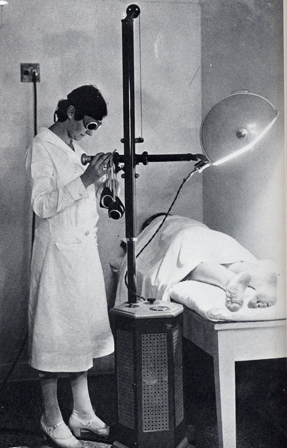
Ultra Violet Lamp Used for Physiotherapy circa 1940
| By
1950 the shortage of trained employees (doctors and nurses) that occurred
during and immediately after World War II had been replenished, and the
addition of Miss Amanda Hardy, R.N. and B.S. to the nursing staff resulted
in a training course for attendants. The course, which was 30 classroom
hours plus ward training, included lectures and demonstrations of nursing
techniques. Though the program was brand new in 1950, Miss Hardy and the
Brattleboro administration hoped to offer more advanced nursing classes
in the future. |
Ultra Violet Lamp Used for Physiotherapy circa 1940 |
|
Hydrotherapy Room circa 1940 |
In the meantime, however, there was no shortage of treatment options for patients, most of which were considered successful. Electric shock therapy was administered for the first time at Brattleboro on September 29, 1949. Between that day and June, 1950, 113 patients were treated with shock, and 45 of those 113 were discharged. Shock treatments averaged 20 sessions per person, and the patients who had been ill for a shorter period of time preceding the therapy tended to respond more favorably. Additionally, Brattleboro offered insulin therapy, which was believed to be an effective way to treat sub-coma patients with schizophrenia who had been ill for less than 1.5 years, or full-coma patients with recent onset schizophrenia. There was also hydrotherapy, expanded recreational and occupational therapy departments, and the addition of a “full-power clinical x-ray machine” in 1949.
|
| The Brattleboro Retreat Auxiliary was another important 1950 addition to the Retreat. This was a group of volunteer ladies, including many hospital physicians’ wives, who planned and organized events for the patients including concerts, tea parties, and summer cook-outs. These activities, along with the beauty parlor, chapel services, library, and other resources provided the patients with many fulfilling activities. |